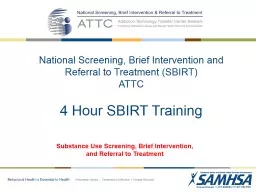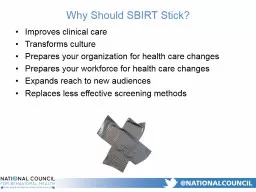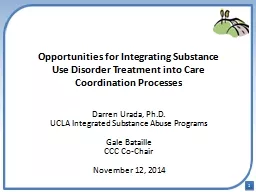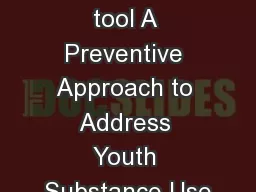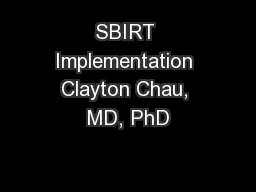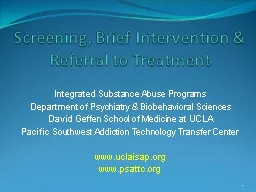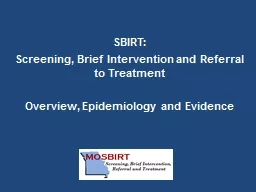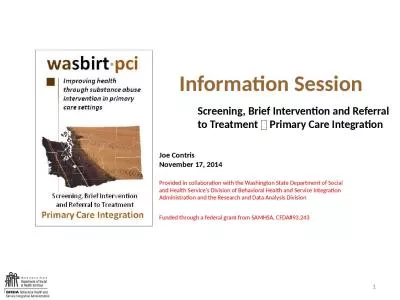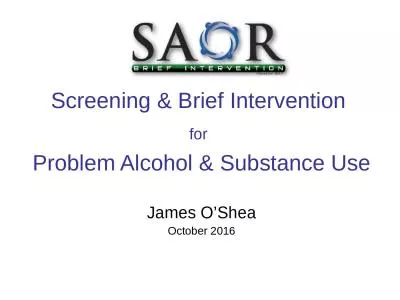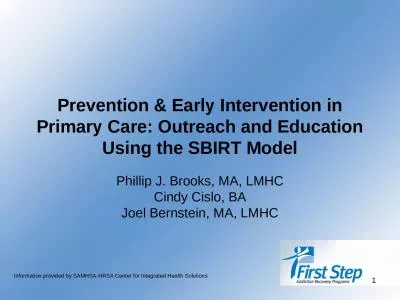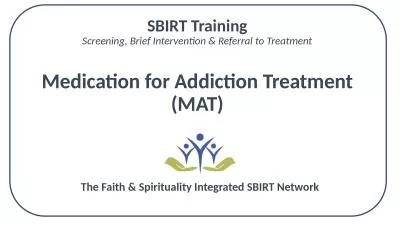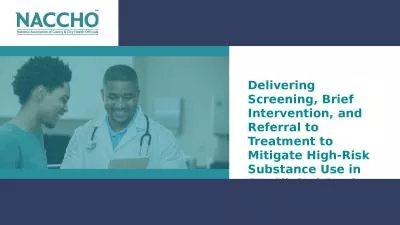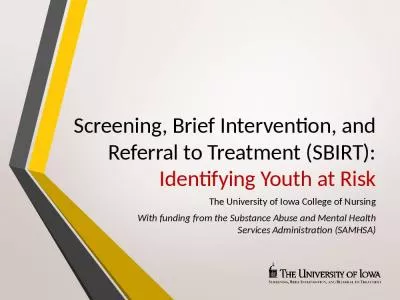PPT-National Screening, Brief Intervention and Referral to Treatment (SBIRT)
Author : mitsue-stanley | Published Date : 2020-01-01
National Screening Brief Intervention and Referral to Treatment SBIRT ATTC 4 Hour SBIRT Training Substance Use Screening Brief Intervention and Referral to Treatment
Presentation Embed Code
Download Presentation
Download Presentation The PPT/PDF document "National Screening, Brief Intervention a..." is the property of its rightful owner. Permission is granted to download and print the materials on this website for personal, non-commercial use only, and to display it on your personal computer provided you do not modify the materials and that you retain all copyright notices contained in the materials. By downloading content from our website, you accept the terms of this agreement.
National Screening, Brief Intervention and Referral to Treatment (SBIRT): Transcript
National Screening Brief Intervention and Referral to Treatment SBIRT ATTC 4 Hour SBIRT Training Substance Use Screening Brief Intervention and Referral to Treatment WELCOME Please introduce yourself to the group. and Referral to Treatment. Core Curriculum . Acknowledgments . The material included in this course is based largely on the works of previously funded SAMHSA grantees.. Other information sources will be noted within the course narration.. Improves . clinical care . Transforms culture. Prepares your organization for health care changes. Prepares your workforce for health care changes. Expands reach to new audiences. Replaces less effective screening methods. for . Integrating Substance Use Disorder . Treatment into . Care Coordination Processes . Darren Urada, Ph.D. . UCLA Integrated Substance Abuse . Programs. Gale . Bataille. CCC Co-Chair. November 12, 2014. Presented by Dawn A. Randolph, MPA. Public Policy Consultant, Georgia Council on Substance Abuse. www.gasubstanceabuse.org. Presented to the House Study Committee on . Childrens. Mental Health - HR 641. Medical Director, Behavioral Health Services. cchau@lacare.org. Updated 04/21/2014. Goals. Definition. Understanding the benefit . The . tool and . the process. The training requirements. 2. Definition. 1. Integrated Substance Abuse Programs. Department of Psychiatry & Biobehavioral Sciences . David Geffen School of Medicine at UCLA . Pacific . Southwest Addiction Technology Transfer Center. www.uclaisap.org. The University of Iowa. Identify factors that make primary care an ideal setting for SBIRT. Identify options on the substance use care continuum. Describe practical aspects of making successful treatment referrals. Overview, Epidemiology and Evidence. Learning Objectives. Module One: Orientation to SBIRT. Know the purpose and basic elements of SBIRT . Know the prevalence and negative health consequences of alcohol and other substance misuse . . . Primary Care Integration. Joe Contris. November 17. , . 2014. Provided in collaboration with the Washington State Department of Social and Health Service’s Division of Behavioral Health and Service Integration Administration and the Research and Data Analysis Division . for. . Problem Alcohol & Substance Use. James O’Shea. October 2016. SAOR Model. Model for Screening & Brief Intervention for problem alcohol & substance developed in 2009. Emerged from work in acute hospital settings . Phillip J. Brooks, MA, LMHC. Cindy Cislo, BA. Joel Bernstein, MA, LMHC. Information provided by SAMHSA-HRSA Center for Integrated Health Solutions. Background. Prescription Drug Epidemic hit its peak in Sarasota County in 2010. Medication for Addiction Treatment. (MAT). The Faith & Spirituality Integrated SBIRT Network. Navigating the Training. Welcome! These health professionals will guide you through your MAT training.* . Presenter Introduction . (. Note: Slide serves as a placeholder for presenter(s) who wish to include their picture and any introductory information.) . First Name and Last Name. Lorem ipsum . dolor. Identifying Youth at Risk. The University of Iowa College of Nursing. With funding from the Substance Abuse and Mental Health Services Administration (SAMHSA). Alcohol is the drug of choice for youth.
Download Document
Here is the link to download the presentation.
"National Screening, Brief Intervention and Referral to Treatment (SBIRT)"The content belongs to its owner. You may download and print it for personal use, without modification, and keep all copyright notices. By downloading, you agree to these terms.
Related Documents

